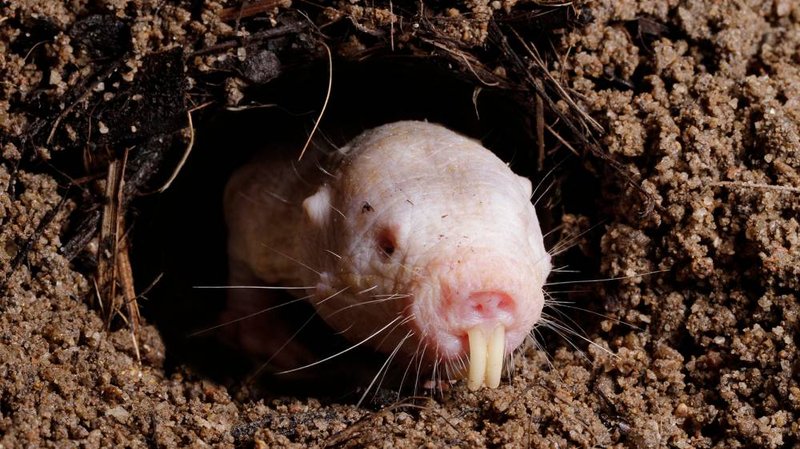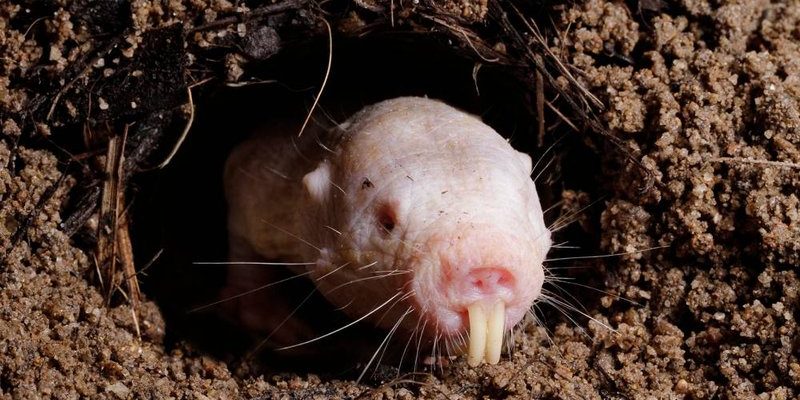
The Naked Mole Rat is one of those quirky creatures that sparks both curiosity and fascination. Imagine a bustling city of tiny, hairless, wrinkly rodents working together in an underground labyrinth. While they might not win any beauty contests, their unusual traits and social behaviors make them truly remarkable. These little critters are not your average rodents; they’re packed with surprises that make them stand out in the animal kingdom.
Native to the hot, arid regions of East Africa, particularly in parts of Ethiopia, Kenya, and Somalia, Naked Mole Rats thrive in a very specific environment. They live in colonies and are known for their complex social structure that’s similar to some insect societies, like bees or ants. You might be wondering why anyone would study these wrinkly rodents when they seem so ordinary at first glance. Well, the Naked Mole Rat has unique adaptations that provide insights into aging, cancer resistance, and social behavior—topics that intrigue scientists and researchers alike.
Physical Characteristics
When it comes to looks, the Naked Mole Rat is quite distinct. They typically measure about 3 to 4 inches long, weighing between 1.5 to 3.5 ounces. Their most notable feature is, of course, their hairlessness. This lack of fur helps them regulate body temperature in their warm underground homes. With loose, wrinkled skin, they can squeeze through tight tunnels with ease. It’s almost like they were designed for an underground lifestyle!
Their large incisors are another standout feature. These teeth are always growing, perfect for digging and eating tough plant roots. They also have a keen sense of smell and some surprising eyesight. You might think they would have poor vision living underground, but they can actually see quite well. It’s like having a built-in survival toolset, perfectly equipped for life below the surface.
| Characteristic | Details |
| Size | 3 to 4 inches long |
| Weight | 1.5 to 3.5 ounces |
| Color | Pink to light brown, hairless skin |
| Habitat | Underground tunnels in East Africa |
| Social Structure | Colonial, eusocial |
| Diet | Roots and tubers |
Habitat and Lifestyle
Naked Mole Rats are true underground dwellers. They create extensive tunnel systems that can stretch over a mile long. These tunnels serve various purposes: from living quarters to storing food. It’s a bit like their version of a high-rise apartment. Each colony can contain up to 300 individuals, and the social structure is fascinating. Naked Mole Rats have a queen, much like bees. The queen is the only female that breeds, while the other females help care for the young and maintain the colony.
A remarkable aspect of their lifestyle is their ability to thrive in harsh conditions. The temperature underground can be quite high, and oxygen levels can drop. Naked Mole Rats have adapted to this environment by having a low metabolism and a unique way of using oxygen efficiently. Some studies even suggest they can survive in low-oxygen environments by relying on a more anaerobic cellular respiration process.
You might be surprised to learn that they communicate using a range of vocalizations. From squeaks to grunts, these sounds help keep the colony coordinated. When one mole rat discovers food, they signal the others to join in. It’s a strong sense of community, where everyone plays their part in ensuring the colony thrives.
Diet and Feeding Habits
Naked Mole Rats are herbivores, primarily dining on a diet rich in plant roots and tubers. This choice of food allows them to stay sufficiently nourished underground, where other food sources can be scarce. They have powerful incisors that help them gnaw through tough plant matter, and it’s incredible how they manage to dig for food while also creating and maintaining their tunnel systems—all in a day’s work.
Here’s the kicker: they don’t drink water like many other animals. Instead, they get moisture from the roots and tubers they consume. This habit not only conserves water but also makes them incredibly resilient in their hot, arid habitat. Their bodies have evolved to be highly efficient at extracting the necessary nutrients from food, allowing them to survive and thrive with minimal water intake.
The Naked Mole Rat’s unique feasting habits also extend to their social structure. When food is found, it’s not just for one; it’s a community effort! They share food as a team, ensuring that everyone in the colony is well-fed and strong. This cooperative feeding method reflects their close bond and social nature.
Reproduction and Lifespan
The reproductive habits of Naked Mole Rats are quite interesting. The queen is the only breeding female in the colony, a role she takes very seriously. Depending on the strength of the colony, she can give birth to several litters a year, each consisting of 2 to 12 pups. The pups are born hairless and defenseless but grow quickly under the watchful care of their colony, especially the non-breeding females, which act like nurturing aunts.
You might be intrigued to know that Naked Mole Rats can live remarkably long lives for rodents. While many rodents have a lifespan of only a few years, Naked Mole Rats can live up to 30 years in captivity! This longevity is quite unusual, and researchers are fascinated by the biological mechanisms behind it. Their resistance to cancer and unique aging processes have prompted scientists to study them for clues about human health and aging.
The social dynamics of breeding in Naked Mole Rats are another area of interest. The queen is not only responsible for reproduction but also for maintaining order in the colony. She can suppress the reproductive capabilities of other females through pheromones, ensuring the colony’s focus remains on survival and efficiency.
Naked Mole Rats and Human Health
You might be wondering why Naked Mole Rats are studied in medical research. Well, their unique physiology offers valuable insights into human health. For starters, their resistance to cancer is a significant focus. Unlike many other animals, Naked Mole Rats rarely develop tumors, making them a point of interest for cancer research. Scientists are working to understand the underlying genetics and biological pathways that give these animals such resilience.
Additionally, their impressive lifespan raises questions about the aging process. As we age, our bodies undergo various changes leading to health issues. Naked Mole Rats, however, show negligible senescence—meaning they don’t appear to age in a conventional way. This aspect has the potential to unlock secrets about aging, possibly leading to advancements in human medicine and longevity.
It’s not just their biology that’s fascinating; it’s also their social behavior. Naked Mole Rats are an example of a eusocial mammal, showing complex social interactions that are rare among mammals. Understanding how they care for one another and maintain their community can offer parallels to human social structures and community health.
Conservation Status
Currently, Naked Mole Rats are not considered endangered. They have adapted well to their specific environments and have a stable population in the wild. However, habitat destruction and climate change pose potential threats. As their environments change, the delicate balance that allows them to thrive could be disrupted.
Conservation efforts for Naked Mole Rats focus primarily on preserving their natural habitats. Understanding their ecological role is crucial in ensuring their continued survival. They play a part in soil aeration through their digging activities and help in the dispersal of plant seeds, which contributes to the health of their ecosystems.
For anyone interested in wildlife conservation, Naked Mole Rats are a perfect example of how even the most unusual creatures can have vital roles in their ecosystems. Supporting broader conservation initiatives that protect their habitats will help maintain the balance of the regions they inhabit.
FAQ
What makes Naked Mole Rats unique compared to other rodents?
Naked Mole Rats stand out due to their hairlessness, unique social structure, and impressive resistance to diseases like cancer. They also live in large colonies, similar to social insects, which is uncommon for rodents.
How do Naked Mole Rats communicate?
Naked Mole Rats communicate through a series of vocalizations, such as squeaks and grunts. These sounds help them convey messages about food, danger, or colony activities, allowing for effective coordination within their underground homes.
What is the role of the queen in a Naked Mole Rat colony?
The queen is the primary breeding female in the colony, responsible for giving birth and maintaining order. She can suppress the reproductive capabilities of other females to ensure the colony’s focus remains on survival and efficiency.
How do Naked Mole Rats handle their underground environments?
Their physiology allows them to thrive in low-oxygen and high-temperature conditions. They have adapted a low metabolic rate and can utilize oxygen more efficiently, making them well-suited for life underground.
Can Naked Mole Rats survive without water?
Yes, Naked Mole Rats can survive without drinking water. They obtain moisture from the roots and tubers they consume, showcasing their incredible adaptability to their arid environment.
Why are Naked Mole Rats studied in medical research?
Researchers study Naked Mole Rats due to their cancer resistance and unique aging traits. Their long lifespan and negligible senescence provide insights into potential aging mechanisms and cancer prevention strategies applicable to humans.
What do Naked Mole Rats eat?
Naked Mole Rats primarily feed on plant roots and tubers. Their powerful incisors help them dig through tough plant matter, ensuring they get enough nutrients to thrive in their underground habitats.
How do Naked Mole Rats contribute to their ecosystem?
By digging tunnels, Naked Mole Rats aerate the soil and help with seed dispersal. These activities contribute to the overall health of their ecosystem, showcasing the importance of even small creatures in maintaining ecological balance.
What threats do Naked Mole Rats face?
While currently not endangered, Naked Mole Rats could face threats from habitat destruction and climate change. Protecting their natural environments is essential for their long-term survival.
How long do Naked Mole Rats live?
Naked Mole Rats can live up to 30 years in captivity, which is remarkably long for rodents. This longevity is a topic of interest for researchers looking to understand the biology of aging.
What is the social structure of a Naked Mole Rat colony?
Naked Mole Rats live in colonies that can consist of up to 300 individuals. They have a complex social structure with a queen, breeding males, and non-breeding females who contribute to colony maintenance and pup care.
Are Naked Mole Rats friendly towards humans?
While Naked Mole Rats are not typically pets, they can be quite docile. Those in captivity are often studied in research settings and can exhibit curiosity towards human handlers, but they generally prefer their underground habitats.
What adaptations help Naked Mole Rats survive in their environment?
Adaptations like hairlessness, efficient oxygen use, and a low metabolic rate allow Naked Mole Rats to survive in harsh underground conditions. Their unique social behaviors further enhance their survival in colonies.
How can I support Naked Mole Rat conservation?
Supporting wildlife conservation organizations that focus on habitat preservation and educated awareness about the importance of Naked Mole Rats and their ecosystems can significantly contribute to their continued survival.

